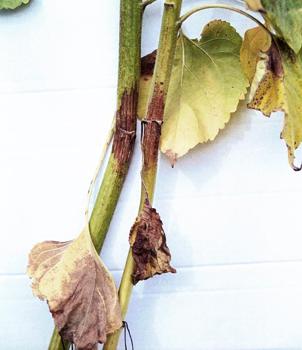Diseases
Gray Stem Spot of Sunflower (Phomopsis) - Diaporthe helianthi Munt.-Cvet. et al. (teleomorph), Phomopsis helianthi Munt.-Cvet. et al. (anamorph) (=Diaporthe arctii (Lasch) Nit., =Diaporthe arctii var. achileae (Auers) Wehm.
Systematic position.
Class Ascomycetes, order Diaporthales, family Diaporthaceae, genus Diaporthe.Biological group.
Facultative parasite.Morphology and biology.
D. helianthi forms exophitic yellow-green septate mycelium; pycnidia with hyaline, lengthened, straight or curved beta-conidia; perithecia with two-celled roundish ascospores. Pycnidia dark-brown, spherical, 120 to 290 microns in diameter, being formed inside the infected tissue under epidermis. The beta-spores in pycnidia are 17 to 42 microns long and 0.5 to 2.7 microns wide. Reproductive body is a spherical dark perithecium with a rostrum, 90 to 430 microns in diameter. Length of the rostrum varies from 260 to 850 microns. The perithecia form in affected tissue separately or in groups, with their neck occurring after maturing on surface of epidermis. Ascospores are two-celled, spherical or cylindrical, 60 to 76.5 microns long, 8.7 to 12.5 microns wide. Sources of infection are perithecia with ascospores on crop debris, picnidia with beta-spores on the affected plants, and infected seeds. First the disease affects basal leaves of sunflower. It appears in phase of 4-12 true leaves, and infects stalks and heads, including seeds. Until budding the disease is rarely visible (less than 1.0%), later it develops more but no more than 10.0%. The infection of sunflower by conidia occurs during the flowering stage and later, when picnidia produce the beta-spores. The dark-brown necroses of triangular or irregular shape form on affected leaves. After transferring the disease to stalks and heads, the brightly-brown necroses form on susceptible plants, and restricted dark necroses form on resistant plants. Affected seeds have no characteristic gloss to its cover, where the picnidia with beta-spores are formed. The greatest harm the pathogen causes to susceptible stalks of sunflower is by provoking their fracture or causing complete drying of its foliage. In this case the biological threshold of disease harmfulness is 5.2% of the destroyed plants. The physiological races are found in the disease.Distribution.
The Gray Stem Spot of Sunflower was registered in the Ukraine for the first time, then in Moldova, and in the Stavropol Territory of Russia in 1990. Now the disease has spread throughout the Ukraine and Moldova. In Russia it is most strongly developed in the Northern Caucasus, intensifying in the Central Chernozem Zone and Middle Volga Basin region (the Volgograd Region). The disease nidus has appeared recently in the Southern Ural (the Orenburg Region).Ecology.
The causal agent of the disease can grow and develop at temperatures ranging from 5.C to 30.C. The optimal temperature for mycelium growth, appearance of picnidia and perithecia of the pathogen, is under 25.C. At optimal temperatures the picnidia are formed over a period of 7 to 10 days, and perithecia over 26 days. D. helianthi affects sunflower most intensively in those places where short-term humidification and average daily air temperature exceeds 20.C during a period of two months.Economic significance.
The Gray Stem Spot of Sunflower can cause sunflower yield losses greater than 46%. The greatest damage to sunflower is observed in Moldova, Ukraine and in the Northern Caucasus of Russia. Control measures include the use of resistant varieties and hybrids, optimal crop rotation, pre-sowing seed dressing, and fungicide treatment of the growing sunflower.Reference citations:
Bogdanova V.N. 1986. In time to find out phomopsis. Sel.skoe khozyaistvo Moldavii, 12: 24-25. (In Russian)Carriere J.B., Petrov M. 1990. Diaporthe (Phomopsis) sp., a new pathogen of cocklebur (Xanthium italicum Moretti) and sunflower (Helianthus annuus L.). Helia, 13: 93-106.
Lesovoy M.P., Parfenyuk A.I. 1996. Methodical peculiarities in breeding of sunflower hybrids with group resistance to agents of the white rot and the phomopsis. Eucarpia. Proceeding of the symposium on breeding of oil and protein crops; 1996 Aug 5-8. Ukraine: Zaporozhye. 102-107 p.
Maric A., Camprag D., Masirevic S. 1987. Sunflower diseases and pests and their control. Belgrade: Nolit. 379 p. (In Serbian)
Muntanola-Cvetkovic M., Mihaljecevic M., Petrov M. 1981. Identity of the causative agent of a serious Phomopsis (Diaporthe) disease in sunflower plants. Belgrad: Institute for Biological Research "Sinisa Stankovic". Nova Hedwigia 34: 417-435.
Skripka O.V., Primakovskaya M.A., Shinkarev V.I. and Matvienko A.N. 1988. The methodical recommendations on detection of the phomopsis (Gray Stem Spot of Sunflower). Moscow: VNIIF. 12 pp. (In Russian)
Wehmeyer L.E. 1933. The genus Diaporthe Nitschke and its segregates. Ann Arbor: University of Michigan Press. 22-33 p.
Yakutkin V.I. 1991. Identification of the cause of Gray Stem Spot of Sunflower and methods of its account. The methodical recommendations. Leningrad: VIZR. 23 pp. (In Russian)
Yakutkin V.I. 1993. Occurrence of Gray Stem Spot of Sunflower in Russia. Mikologiya i fitopatologiya, 27, 5, p. 68-73 (In Russian)
Yakutkin V.I. 1998 a. Methods of identification and account of phomopsis of sunflower. Collection of methodical recomendationes on plant protection. St. Petersburg: VIZR. 191-207 p. (In Russian)
Yakutkin V.I. 1998 b. Gray Stem Spot is a new disease of sunflower in Russia. 7th International Congress of Plant Pathology; 1998 Aug 9-16; Edinburg, Abstracts, V. 6. Scotland: United Kingdom. 6 p.
Yakutkin V.I. 2001. Diseases of sunflower in Russia and their control. Zashchita i karantin rastenii, 10: 26-29. (In Russian)
Yang S.M., Berry R.W., Luttrel E.J., Vonkaysone T. 1984. A new sunflower disease caused by Diaporthe helianthi in Texas. Plant Diseases, 68: 254-255.
© Yakutkin V.I.


